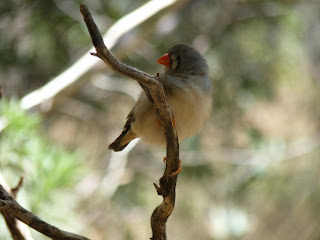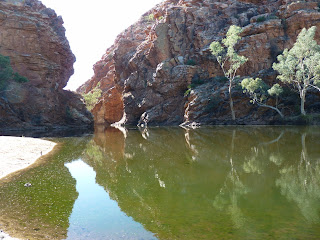We
changed our itinerary around a bit here, backtracking from Kings Canyon, back
through Erldunda, then up to Alice. And boy am I glad we did! You see, the
original plan was to take the Mereenie Loop from Kings Canyon around to Glen
Helen Resort; an unsealed road, a good 180kms or so of it, and a bit rough at
the best of times. We decided not to as there’d been quite a bit of rain, and I
didn’t want to get bogged again as I had back at William Creek. Having a chat a
few days down the track with people who’d done the Loop when we’d intended, but
in proper, big 4WD’s with off road trailers, said the road had really shaken
things up. People’s headlights smashed, fridges in their trailers fallen apart,
and doors shaken off. We wouldn’t have stood a chance in our little ‘rig’!! So
although it meant about another $100 in petrol, and an extra 300kms or so, I
think it turned out pretty much the same, but far more relaxing!
So
while fellow travellers were doing it tough on the Mereenie Loop, Elliot and I
were enjoying being in Alice Springs – re-stocking supplies, enjoying a
fantastic campsite, and going to Alice’s premier tourist attraction, ‘The Alice
Springs Desert Park’. It was fantastic!! Set up beautifully to showcase all the
desert has to offer, which is a lot! We were there about 5 hours and didn’t see
it all. This was where we saw the most bird life (in their bird show, aviaries,
and just flying about in the bushland all around), plus learnt a heap about how
Aboriginal people used to live in such a harsh environment. Lots of interesting
information about the wildlife, plants, eco-systems, and the biggest nocturnal
house I’ve ever seen! So cool, and well worth a visit if you’re ever in Alice.
Here
are some photos:
A Barn
Owl (??) – very common owl in the world, but gorgeous anyway!
Might
be a Grey Headed Honeyeater - (sorry, don’t know my birds too well!) Lovely
though!
A Painted Finch (I think)
Zebra
Finch? Very cute and fluffy anyway!!
I know
this one!! It’s a Tawny Frogmouth! Very cool – it just hangs around, disguised
as a tree stump/branch. It’s an ‘opportunist’, as in, it just waits for some
kind of insect to fly by, and grabs it. Think it’s part of the Kingfisher
family, but it doesn’t fly too well. Just as well it likes hangin’ out!
A
Brown Falcon. Absolutely beautiful bird. Watching the birds of prey in the bird
show was amazing. Their aeronautic skills quite extraordinary. Just a slight
turn of the head, or slight angle change of the tail can totally change their
direction in a split second. The black markings under its eyes are to reflect
the sun – kind of like a pair of sunnies!
Not a
particularly great shot of a Bush Stone Curlew, but a beautiful bird. Nocturnal
(huge eyes), and maybe got long legs for stalking through the grass? Can’t
remember :(
A new
‘Aussie Animal favourite’ of mine, the Thorny Devil. They are so cute!!! Just small, maybe 15 – 20 cms
long, and they have a really stiff walk, like they’ve got arthritis. They’ve
adapted their walk and markings to look like a dead leaf fluttering in the
breeze across the ground. Can’t see it myself! Just looks like a cute spiky
lizard! I want one!!!!!
Of
course, you can’t have an Aussie Desert Park without a few snake species – this
is a King Brown (aka Mulga snake).
The
stunning White Winged Fairy Wren. Apparently the only desert bird to have such
bright colours. Depending on how the sunlight caught it, it looked either
Cobalt or Electric blue. It looked quite like an iridescent blue butterfly when
flitting around. Just gorgeous.
No
idea what this one is, but I loved watching it fossicking around in dead leaves
on the ground to find its food. Was pretty cute too!
Sat in
on an interesting talk about hunting and gathering methods of the local
Aboriginal people. Elliot’s holding a shield here. Apparently, shields were
quite rare, even when the Aboriginal people were living traditional lives. So
when they did decide to make them, they made them out of Mulga wood (the most
durable one in the area), and made them to fit the particular man that would
use it. Because of its rarity, this one is quite precious, and it’s also one
tool or traditional item that very few modern Aboriginal people would know how
to make. We were told that, like non-Aboriginal folk, contemporary Aboriginal
people now go to the shops to buy food, and if they go hunting, they do it in
4WDs with rifles. No more spear throwing and traditional
hunting/trapping/gathering/processing methods any more. The most important
thing now, is that their languages are kept alive. When that dies, so does any
link they have to their fokelores and meaning behind their storytelling. That’s
the keystone to what’s left of their cultures.
This
is Elliot with a desert boomerang. It’s a lot longer and straighter than the
ones you might be familiar with. This one is thrown horizontally, and does not
come back. Its purpose is to ‘kneecap’ emus and break large birds wings – stop
them moving, so the men can get in there quick and finish the animal/bird off
as quickly as possible with a blow to the head with a club. Again all these
tools were made of Mulga. Boomerangs in tropical wetlands, or coastal areas
were smaller, more curved and designed to come back, as going into the water to
retrieve your boomerang would be like risking your life due to all the crocs
and other nasties in the water! Clever huh?
This
is a type of Mulga. I love the bark on it! Reminded me of a Piñata!!
This
was pretty special – a full moon over Alice. I could just imagine all the
desert predators we’d seen at the Desert Park having fantastic hunting sessions
in this bright moonlight. Full moon over the desert – magic!
A
visit to Alice Springs ED wasn’t so magic though. Elliot managed to break his
toe whilst in thongs. Foot slipped off the pedal, straight into the ground.
Ouch! Culdn’t have been that bad though – he was back into shoes in about 3
days, then continuing with hikes as usual. We were SO lucky!!
West
MacDonnell Ranges
The
great thing about the WMR is you can see so much in a relatively short
distance. Glen Helen is about the furthest west you can get from Alice as a
place to stay, before the Merleenie Loop curls around to either Hermannsburg or
off to Kings Canyon – and it’s only about 160kms from Alice. Along the north
road through the WMR, you can see about 6 gorges a number of waterholes, and
other attractions worth a look. I thought it was a great place if you’re short
of time. Needless to say, it was beautiful, peaceful and loaded with meaning in
Aboriginal fokelore. Here are some pics…
The
landscape is so heavily textured, and the hills have this extraordinary ‘undulating’
pattern, with many different layers of rock types, with strips of green, also
looking regulated. It looked to me like different colours of wool had been laid
down to make their patterns. Very unusual!
Some
of these stratas up close. They looked a lot like dry stone walls. So straight
and perfect. I love the perspective in the above shot.
This
is Mt Sonder. Aboriginal people believe it looks like a pregnant woman lying on
her back. I can see it…can you?
These
are the cliffs leading into Glen Helen Gorge, where we camped. I could see
these cliffs through the window when I was having a shower!! Nae bad eh?
Wonderful birdlife around these gorges. It’s amazing what a difference water
makes!
And
this was just across the road and up a bit from where we camped. So peaceful! I
think the water is part of the Finke River – the main river in the Red Centre.
I
found this awesome bug wriggling around on its back at the campsite. It was
iridescent green – like metallic paint, especially on its underside. Very
beautiful and eyecatching.
Redbank
Gorge…
…is
the narrowest in WMR, and never heated by direct sunlight. As a consequence,
the water is absolutely freezing, and animals/reptiles that fall in it whilst
drinking or whatever, usually perish. Neither Elliot or I ventured in (due to
the risks), but admired the incredible rock formation and reflections in the
dark, still water…
‘Scuse
the socks ‘n’ Crocs – toe still too sore for shoes here! Lovely portrait of him
though :)
Ormiston
Gorge
This
Gorge was huge, but incredibly peaceful. Elliot and I had lunch way up the
gorge floor, with no people around. I lazed in the sun on the rocks afterwards,
whilst Elliot looked in the waterholes at the little micro-worlds that go on in
there. Of all the gorges we visited, I think this one had the most ‘life’ that
we could see – lots of birds, some fish, and fantastic dragonflies. Felt so
relaxed afterwards…
Me on
the way down to the Gorge floor, after the lookout. The Gorge cliffs rise about
250m above the waterholes below. Quite magnificent. Again, the lines and angles
of the rocks really struck me. Here’s what scientists say about how it became
the way it is:
The
sun was catching the tops of the branches of this beautiful gum tree, making
them look silver. The branches I’ve taken a photo of remind me of bolts of
lightening with their crooked angles and silver lines.
Our lunch spot for the day – at the end of the waterhole here.
Another of the waterholes. This had fish in it.
I
loved the patterns in these creek bed rocks.
One of
the many electric blue dragonflies busying around. Lucky this one stopped long
enough for me to get a picture.
…and a
flame red one. Lots of them too!
Ellery
Creek Bighole
…the
largest waterhole in the area. Elliot and I thought ‘Right, today’s the day
we’ll take a dip in one of these – it’ll be nice!’ WRONG!!! It was absolutely freezing!! Not enjoyable in the least –
just painful really. I was in and out in less than 10 seconds, and could hardly
breathe. Terrible!! Reminded me of the polar plunge I did in Antarctica – no
joke!! Nevertheless, it was beautiful. Here are some shots…
Look
at that! Looked SO inviting – just swim across the first waterhole, cross a bit
of sand into the next shimmering one…alas, it was not to be :(
Took a
photo instead.
The
Ochre Pits
This
was beautiful, and quite special. To Aboriginal people, Ochre was a highly
valued trading commodity, used for all sorts of ceremonies (as it is still today
for some remaining tribes). The signs at this site emphasised its importance to
Aboriginal people, and for visitors to not touch the rocks (and definitely not take any home!) The four
typical colours of Ochre used – red, yellow, black and white, had different
meaning, and were therefore used to different extents and for different
purposes.
Ochre
cliffs
The
different colours available at this site.










































No comments:
Post a Comment